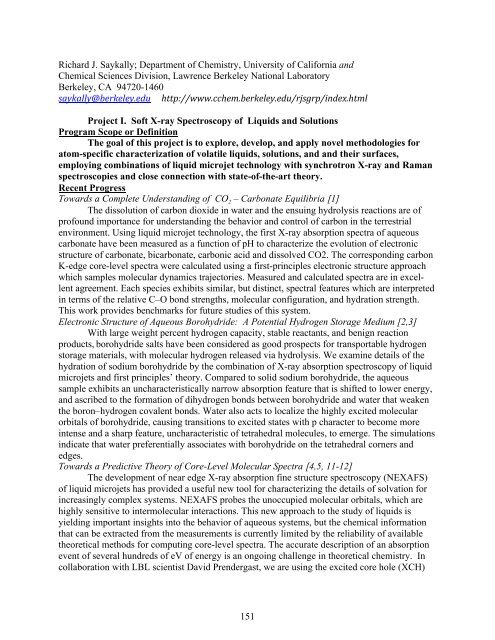Eighth Condensed Phase and Interfacial Molecular Science (CPIMS)
Eighth Condensed Phase and Interfacial Molecular Science (CPIMS)
Eighth Condensed Phase and Interfacial Molecular Science (CPIMS)
Create successful ePaper yourself
Turn your PDF publications into a flip-book with our unique Google optimized e-Paper software.
Richard J. Saykally; Department of Chemistry, University of California <strong>and</strong><br />
Chemical <strong>Science</strong>s Division, Lawrence Berkeley National Laboratory<br />
Berkeley, CA 94720-1460<br />
saykally@berkeley.edu http://www.cchem.berkeley.edu/rjsgrp/index.html<br />
Project I. Soft X-ray Spectroscopy of Liquids <strong>and</strong> Solutions<br />
Program Scope or Definition<br />
The goal of this project is to explore, develop, <strong>and</strong> apply novel methodologies for<br />
atom-specific characterization of volatile liquids, solutions, <strong>and</strong> <strong>and</strong> their surfaces,<br />
employing combinations of liquid microjet technology with synchrotron X-ray <strong>and</strong> Raman<br />
spectroscopies <strong>and</strong> close connection with state-of-the-art theory.<br />
Recent Progress<br />
Towards a Complete Underst<strong>and</strong>ing of CO 2 – Carbonate Equilibria [1]<br />
The dissolution of carbon dioxide in water <strong>and</strong> the ensuing hydrolysis reactions are of<br />
profound importance for underst<strong>and</strong>ing the behavior <strong>and</strong> control of carbon in the terrestrial<br />
environment. Using liquid microjet technology, the first X-ray absorption spectra of aqueous<br />
carbonate have been measured as a function of pH to characterize the evolution of electronic<br />
structure of carbonate, bicarbonate, carbonic acid <strong>and</strong> dissolved CO2. The corresponding carbon<br />
K-edge core-level spectra were calculated using a first-principles electronic structure approach<br />
which samples molecular dynamics trajectories. Measured <strong>and</strong> calculated spectra are in excel-<br />
lent agreement. Each species exhibits similar, but distinct, spectral features which are interpreted<br />
in terms of the relative C–O bond strengths, molecular configuration, <strong>and</strong> hydration strength.<br />
This work provides benchmarks for future studies of this system.<br />
Electronic Structure of Aqueous Borohydride: A Potential Hydrogen Storage Medium [2,3]<br />
With large weight percent hydrogen capacity, stable reactants, <strong>and</strong> benign reaction<br />
products, borohydride salts have been considered as good prospects for transportable hydrogen<br />
storage materials, with molecular hydrogen released via hydrolysis. We examine details of the<br />
hydration of sodium borohydride by the combination of X-ray absorption spectroscopy of liquid<br />
microjets <strong>and</strong> first principles’ theory. Compared to solid sodium borohydride, the aqueous<br />
sample exhibits an uncharacteristically narrow absorption feature that is shifted to lower energy,<br />
<strong>and</strong> ascribed to the formation of dihydrogen bonds between borohydride <strong>and</strong> water that weaken<br />
the boron–hydrogen covalent bonds. Water also acts to localize the highly excited molecular<br />
orbitals of borohydride, causing transitions to excited states with p character to become more<br />
intense <strong>and</strong> a sharp feature, uncharacteristic of tetrahedral molecules, to emerge. The simulations<br />
indicate that water preferentially associates with borohydride on the tetrahedral corners <strong>and</strong><br />
edges.<br />
Towards a Predictive Theory of Core-Level <strong>Molecular</strong> Spectra [4,5, 11-12]<br />
The development of near edge X-ray absorption fine structure spectroscopy (NEXAFS)<br />
of liquid microjets has provided a useful new tool for characterizing the details of solvation for<br />
increasingly complex systems. NEXAFS probes the unoccupied molecular orbitals, which are<br />
highly sensitive to intermolecular interactions. This new approach to the study of liquids is<br />
yielding important insights into the behavior of aqueous systems, but the chemical information<br />
that can be extracted from the measurements is currently limited by the reliability of available<br />
theoretical methods for computing core-level spectra. The accurate description of an absorption<br />
event of several hundreds of eV of energy is an ongoing challenge in theoretical chemistry. In<br />
collaboration with LBL scientist David Prendergast, we are using the excited core hole (XCH)<br />
151
















